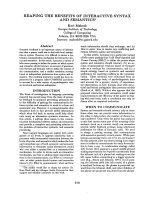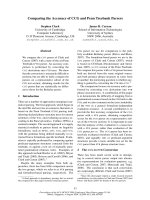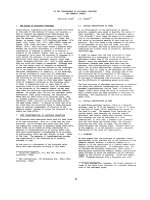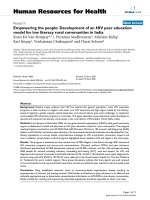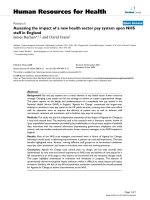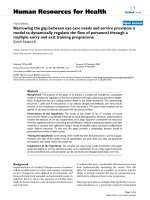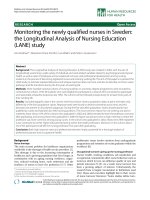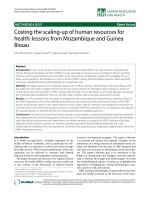báo cáo sinh học:" Reviewing The Benefits of Health Workforce Stability James Buchan" doc
Bạn đang xem bản rút gọn của tài liệu. Xem và tải ngay bản đầy đủ của tài liệu tại đây (209.26 KB, 5 trang )
REVIEW Open Access
Reviewing The Benefits of Health Workforce Stability
James Buchan
Abstract
This paper examines the issue of workforce stability and turnover in the conte xt of policy attempts to improve
retention of health workers. The paper argues that there are significant benefits to supporting policy makers and
managers to develop a broader perspective of workforce stability and methods of monitoring it. The objective of
the paper is to contribute to developing a better understanding of workforce stability as a major aspect of the
overall policy goal of improved retention of health workers. The paper examines some of the limited research on
the complex interaction between staff turnover and organisational performance or quality of care in the health
sector, provides details and examples of the measurement of staff turnover and stability, and illustrates an
approach to costing staff turnover. The paper concludes by advocating that these types of assessment can be valu-
able to managers and policy makers as they examine which policies may be effective in improving stability and
retention, by reducing turnover. They can also be used as part of advocacy for the use of new retention measures.
The very action of setting up a local working group to assess the costs of turnover can in itself give managers and
staff a greater insight into the negative impacts of turnover, and can encourage them to work together to identify
and implement stability measures.
Introduction
This paper examin es the issue of workforce stability and
turnover in the context of policy attempts to improve
retention of health workers. Staff turnover is often the
primary topic for monitoring and research when reten-
tion is being examined, and can give insights into trends
in outflow from the health care organisation. This is
particularly relevant at a t ime of global HRH shortages
[1,2]. However a focus only on turnover- on those who
leave, is only part of the picture. Pol icy makers and
managers also require an insight into why some staff
stay, and what “staying” and workforce stability can con-
tribute to, service delivery, staff workload, and the multi-
ple dimensions of organisational performance, including
costs. This paper argues that there are significant bene-
fits to supporting policy makers and managers to
develop a broader perspective of workforce stability and
methods of monitoring it. The objective of the paper is
therefore to contribute to developing a better under-
standing of workforce stability as a major aspect of the
overall policy goal of improved retention of health
workers.
Background
Why should the issue of health workforce stability be
important? Retaining and developing the workforce
("talent management”) is generally regarded as a major
human resource objective for any organisation. In health
care there is a general assumption that staff turnover
(the opposite of stability), will negatively effect both
access to care, and the level and quality of healthcare
being provided. Turnover may reduce staffing and
patient contact time; can add to organisational c osts, if
temporary cover for staff who leave (e.g. overtime pay)
and recruitment of replacements incurs additional costs;
and may reduce individual and organisational perfor-
mance through the loss of experienced staff, and by
undermining teamwork [3,4].
Methods
The paper is based on a desk review of published and
official sources, and analysis of workforce data from offi-
cial sources.
Results and Discussion
There is a paucity of research which fully examines the
complex interaction between staff turnover and organi-
sational performance, especially quality of care in the
health sector. There have been some exploratory studies,
Correspondence:
Professor, Queen Margaret University, Edinburgh, UK
Buchan Human Resources for Health 2010, 8:29
/>© 2010 Buchan; licensee BioMed Central Ltd. This is an Open Access article distributed under the terms of the Creative Commons
Attribution License ( which permits unrestricte d use, distri bution, and reproduction in
any medium, provided the original work is prop erly cited.
and some which have looked at staffing levels and
outcomes, and examined turnover rates as one proxy
measure for variations in staff satisfaction [5-9]. Few
have taken the impact of turnover or stability rates on
performance as the primary focus of examination.
Where such research has been conducted, mainly in
developed countries, and focusing on nursing staff, there
are some powerful messages for policy makers and man-
agers. For example, one US study reported that health
care organizations with the lowest nurse turnover rates
(less than 12 percent) had the low est risk-adjusted mor-
tality scores, as well a s the lowest severity-adjusted
length-of-stay, and that for health care organizations
with turnover rates in excess of 22 percent, the severity
adjust ed average length-of-stay was 1.2 days longer than
those with the lowest turnover rates. The authors noted
that whilst these findings do not establi sh a c ausal rela-
tionship, they did suggest that higher rates of turnover
among the nursing staff probably lead to decreased effi-
ciency and productivity, which in turn affects patient
care [10]. Other detailed research studies are underway
which will focus on the links between turnover and
measur es of outcome [11,12]; others ha ve also identified
the need to examine the impact of so-called staff
“churn": a continuous high level of turnover, often
accompanied by vacancies and reliance on short term
cover by temporary staffing [13].
Whilst there may be relatively little research evidence
on the impact of health workforce turnover/stability on
care outcomes, there remains a need for organisations
to be able to measure workforce turnover and stability,
and assess its impact on costs
Most research which focuses on health worker retention
and which attempts to measure it uses turnover as a main
indicator. Turnover, and the alternate terms of “attrition”
or “wastage” are usually expressed in terms of the % of
staff of a particular occupation or workplace who have left
the organisation (or have moved jobs) within the last
twelve months. The terms “attrition” and “wastage” are
normally applied when the measurement is the % of staff
who have left the organisation or system under scrutiny,
whilst “turnover” is more often applied if all job moves
(including those within the system) are being a ssessed
[1-3,14].
This type of turnover data is routinely used as a
method of comparing the “leaving” rates in different
workplace units or organisations, and can be a method
of benchmarking variations in rates across systems or
organisations. A number of standard measures of turn-
over can be used, the main requirement being consis-
tency of definition and application, to allow comparison
over time and b etween employing units. T he recent
WHO/World Bank/USAID handbook [2] has suggested
that the “workforce loss ratio” can be calculated by
using number of workers who have left in the last year
as numerator, and total number of health workers as
the denominator
.
This is the standard approach- deter-
mining the loss over the year as a proportion of the
total workforce [see also [14]].
If the reason for monitoring is to assess the ability of
the organisation or system unde r scrutiny to retain staff
it is important that any monitoring can differentiate
between permanent and temporary moves, and what has
been termed “involuntary” turnover or attrition (e.g.
statutory retirement, ill health, death) and “voluntary”
turnover, resignation or attrition [2,15]. Research using
turnover or attrition data can give policy makers an
insight into varying rates in different cadres of worker,
and different reasons for attrition. One recent study, for
example, highlighted that attrition of doctors and regis-
tered nurses in Kenya was much higher at provincial
hospitals than at district hospitals or health centres,
whereas the opposite pattern was found for laboratory
staff and pharmacists [16]. It also found that resignation
was the main factor in attrition of doctors and clinical
officers, whilst the main reason for attrition of nurses
was retirement.
One limitation of the standard measure of turnover
(leavers in the year/total workforce) is that over the
time period under measure it does necessarily differenti-
ate well when comparing units with high and repeated
turnover in a few posts, and those with lower turnover
in more posts [13,17]. This can limit its utility as a mea-
sure of retention as it measures the leaving rate and
gives less insight into how many staff are staying, and
for how long. As noted earlier, a focus on turnover is a
focus on the “leavers”, and there s hould also be some
consideration of “stayers” if retention is the focus.
Developing an understanding of the stability in the
workforce can provide managers and policy makers with
a better understanding of the labour dynamics both
internally, within the organisation, and externally, in
terms of how the organisation connects to the wider
labour markets. There are several different possible
measures of workforce stability which can be used to
give an insight into how many staff stay with the organi-
sation, for what time period.
One indicator which can be used to assess workforce
stability is the average years in post reported by staff
group or work location [18]. A second measure of stabi-
lity is to calculate the stability rate or “index” for each
location, occupational group or profession. The stability
index assesses the proportion of staff who were in post
at the beginning of the year who were still in post at the
end of the year. As data is collected over a longer period
of time, stability indices for 1 year, 2 years (i.e the % of
staff who have remained in post at end of two years),
and longer can be calculated, giving a better insight into
Buchan Human Resources for Health 2010, 8:29
/>Page 2 of 5
the relative rates of rete ntion of diffe rent types of staff,
or different organisations within the system under scru-
tiny. This type of measure may be of utility in most
healthcare settings where HRH data collection is limited,
rather than more sophisticated indicators that require
Table 1 gives an example of the use of stability index
data. It is based on data collected by the National
Health Service (NHS) in Sco tland. There are 14 main
regional employing organisations (Boards) within the
NHS in Scotland and the Table presents the one and
two year stability rates for all staff nationally, and in
each of the fourteen Boards. The overall workforce (full
time equivalent) is approximately 130,000, including
approximately 11,000 doctors and 40,000 registered
nurses. Boards vary significantly in size; the largest
employs over 35,000 staff. Two year stability rates for
nurses and doctors are also shown . The rates are calcu-
lated by estimating the percentage of staff that were in
substantive posts at 30 September and who were still in
substantive posts within the National Health Service
(NHS) in Scotland in the same NHS Board and the
same staff group a year later (index 1), and two years
later (index 2).
The data is presented for each Board, in anonymised
form, with a ranking of the two year stability rate for all
staff (lowest stability rate at top- “Board A”). A quick
examination o f the data in Table 1 provide s some
immediate insights and underlines how useful stability
data can be, particularly if it is collated beyond one year.
For example it is evident that there is marked variation
between Boards in the stability rate for all staff - the 2
year rate varies between 67% and 80.5%. The two year
stability rates for doctors and for nurses are higher than
the average fo r all staff groups. This is perhaps not
unsurprising as these health professional groups are bet-
ter paid and more likely to be located within career
structures which will assist in retaining them in the
health sector than are some “support” staff in clerical
and administrative jobs; furthermore, as health profes-
sionals their skills will be less transferable to non health
settings. There is also variation in the ranking of the
two year rate- Board A which has the lowest stability
rate for all staff, does not report the lowest rate for doc-
tors (Board I) or nurses (Board N). Assessment of the
data by size of Board can also give some indication of
the possible i mpact of organisation size, but also has to
be qualified by the recognition that “smaller” Boards (by
workforce size) tend to be relatively rural, remote or
island based.
This relatively straightforward measure of stability can
assist in inform managers and policy makers about
which occupations have relatively good or poor stability,
or which organisations are retaining proportionately
more staff for more time. As such it can point to “pro-
blem” ar eas. The se may be areas with low stabili ty
where greater staff stabilit y is required. The analysis can
also identify organisations with high desired stability
rates which may have best practice methods that can be
identified and networked.
One of the benefits of this type of measure of stability is
its utility. With some caveats about interpretation of data
where the workforce populations are small [13,17] the sta-
bility rate is simple to measure, and simple to understand.
It can be no more complex to collect data on stability than
it is on turnover. Where new HR information systems are
being developed, or current systems upgraded, considera-
tion should be given to collating and standardising the use
of the stability rate indicator. More complex measures of
stability can also be used if an employing organisation
wishes to develop a more detailed insight into stability and
the length-of-service structureofthestafftofacilitate
inter-organisation comparisons [19].
Whilst routine collection and analysis of turnover and
stability data can give an insight into level of staff reten-
tion and reasons for staying, or le aving, an estimate of
the costs of turnover can assist in raising awareness of
the need to improve retention, and can contribute to
advocacy for policy interventions to improve retention
[3,8,10,20,21]. In addressing issues related to costs of
turnover, it is important first to note that there can ben-
efits as well as costs to the employing organisation when
it experiences staff turnover (see Table 2). The critical
issue, as noted earlier, is that any unplanned and unne-
cessary ("voluntary”) turnover should be prevented, if at
all possible, in the interests of achieving greater stability
in the workforce.
Table 1 2 year stability rate (%), NHS Scotland, selected
staff groups and all staff, by regional Boards (A to N)
Nursing Medical All staff All staff 2007-8
All 85.1 82.8 75.4 88.4
A 89.3 84.5 67.0 84.8
B 85.5 80.0 73.0 86.0
C 85.3 80.6 73.8 87.0
D 85.0 83.7 74.2 88.4
E 85.4 83.7 74.9 89.1
F 88.9 83.5 76.4 89.5
G 82.0 87.2 77.3 89.7
H 82.3 81.8 77.7 90.3
I 81.2 86.7 77.7 90.5
J 87.0 83.1 78.0 90.6
K 87.0 87.7 78.6 91.0
L 88.0 92.6 79.6 91.1
M 88.3 76.8 80.0 91.3
N 81.3 72.2 80.5 92.6
(1 year stability rate for all staff in italics)
Source: Scottish Workforce Information Standard System (SWISS)
Buchan Human Resources for Health 2010, 8:29
/>Page 3 of 5
From a management perspective, the potential benefits
of some level of turnover can include ‘freeing up’ of
posts to allow new staf f with new ideas and energy into
the organisation, opportunities fo r cost reduction
through staff reduction or deployment, and through ‘los-
ing’ disaffected staff who would otherwise exhibit other
forms of withdrawal behaviour, such as absence from
work. There is however no consensus on what is the
“ideal” level of turnover[14], and some potential benefits
may be only short term.
However, as noted earlier in the paper it is clear that
there can be a range of organisational costs and negative
impacts on care associated with any unnecessary turn-
over of staff. Assessing the c ost of turnover should
therefore be an integral element in the approach to
maintaining workforce stability. If the typical or average
cost of turnover of staff is known, this can assist in
assessing the impact on the organisation of different
levels of turnover, and can also provide managers with
an indication of the cost effectiveness of improving
retention through turnover reduction (or stability
increase) strategies.
There is little published data or information on turn-
over costs in the health sector and much of that which
does exist stems from the United States. Most studies
attempt to arrive at a cost per individual staff member
“leaving”, and then calculate a total organisational cost
per annum. Costs per staff are usually examined in at
least four components-
separation costs (the costs
incurred by the staff member leaving),
temporary repla-
cement costs (the costs of covering the post made
vacant by the staff member leaving- e.g use of an agency
staff,sueofovertimeworkbyremainingstaffetc),
recruitment costs (the costs in advertising and selecting
the replacement, and providing relocation costs), and
induction costs (including “lost” productivity, until the
replacement reaches the same level of productivity as
the staff member who h ad left) [3,8,20,21]. Initial costs
of training the worker are usually not included.
It should be recognised that actual turnover costs may
vary significantly between individual employees,
depending on the grade and experience of the worker,
and on the replacement strategy used by the employer
[3,20,21]. For experienced staff at senior level it is likely
that turnover costs will be significantly higher than for
junior staff, due to longer periods of induction and, in
some specialities and occupations, because of skills
shortages and difficulties in recruitment.
Turnover costs will also vary depending upon the
replacement strategy being adopted (e.g. replacing an
experienced worker with a less experienced worker is
likely to lead to lower replacement costs, but lower pro-
ductivity, in the short term at least) and are likely to
vary according to the clinical and geographical setting.
There are a number of ways that the overall impact of
staff turnover costs at organisation level can be illu-
strated, such as:
• percentage of paybill;
• cost per patient day;
• cost saving of reduction in turnover
Table 3 gives an example using % of paybill Using
assumptions of 7 per cent turnover and turnover costs
of $8,000 per nurse in an organisation which employs
500 nurses, this would be equivalent to turnover costs
of $280,000 per annu m. If the turnover was reduce d to
5 per cent per annum, the illustrative example suggests
a cost saving to the organisation of $80,000 per annum.
This approach to estimating turnover costs ensure s
that there is sufficient detail at the level of the individual
‘leaver’ to allow aggregated data to be used as a ‘not less
than’ total cost to the organisation. The example in
Table 3 above illustrates the potential magnitude of
turnover costs at organisational level, and also reveals
the potential cost savings which management could
achieve by reducing turnover. Clearly, as noted above,
not all turnover is “bad” for the organisation, but any
turnover which could ha ve been prevented through
management action would have reduced turnover costs.
Improving workforce stability can carry with it a benefit
to the organisation in terms of reduced cost.
Table 2 Potential Organisational Costs and Benefits of Staff Turnover
Costs Benefits
Loss of Experienced staff ’New Blood’
- Lost Knowledge - New Knowledge
- Decreased Morale - Improve Morale
Constraint on Quality/Level of Service Allows Career Progression
Separation Costs Increase in Organisation Flexibility: e.g. skill mix change
Temporary Replacement Costs Opportunity for Cost Reduction/Consolidation
Recruitment Costs Decrease in other ‘Withdrawal’ Behaviour eg Absenteeism
Induction/Training Costs
Source: adapted from (3)
Buchan Human Resources for Health 2010, 8:29
/>Page 4 of 5
One recent study in the US [22] estimated that total
turnover costs for a hospital system employing 5000
employees was between $US17 and $29 million.
Another study [21] focusing on costs of ind ividual turn-
over rather than organisational, highlighted nurse turn-
over cost assessments of between US$21,500 and US
$31,500 per nurse, with a rough “rule of thumb” that
the cost of staff nurse turnover normally fell between
0.75 and 2.0 times annual sal ary, depending on replace-
ment strategy and other factors.
Conclusion
Intuition would suggest that improving retention and
stability of the health workforce brings benefits to staff,
the organisation and those being cared for. The limited
research available does provide some support for this,
and gives insight in to how health workforce stability can
contribute to reduced costs, improved productivity and
better care outcomes. Of equal importance, and more
immediate utility in most organisations, is the possibility
of introducing a measure or indicator of staff stability,
and of examining the costs of staff turnover. These
types of assessment can be valuable to managers and
policy makers as they examine which p olicies may be
effective in impro ving stability and retention, by redu-
cing turnover. They can also be used as part of advocacy
for the use of new retention measures. An additional
benefit can be that the very action of setting up a local
working group to assess the costs of turnover can in
itself gives managers and staff a greater insight into the
negative impacts of turnover, an d can encourage them
to work together to identify and implement stability
measures.
Authors’ contributions
JB conceived, researched and wrote the paper
Competing interests
The authors declare that they have no competing interests.
Received: 4 June 2010 Accepted: 14 December 2010
Published: 14 December 2010
References
1. Diallo K, Zurn P, Gupta N, Dal Poz M: Monitoring and evaluation of
human resources for health: an international perspective. Human
Resources for Health 2003, 1:3.
2. Dal Poz M, Gupta N, Quain E, Soucat A: Handbook on monitoring and
evaluation of human resources for health: with special applications for low
and middle income countries WHO Geneva; 2009.
3. Buchan J, Seccombe I: Nurse turnover costs: A review for the Royal College of
Nursing (IMS Report No. 212) Brighton, UK: University of Sussex, Institute of
Manpower Studies; 1991.
4. McConnell CR: Staff turnover: Occasional friend, frequent foe, and
continuing frustration. Health Care Manager 1999, 8:1-13.
5. Stoller J, Orens D, Kester L: The Impact of Turnover among Respiratory
Care Practitioners in a Health Care System: Frequency and Associated
Costs. Respiratory Care 2001, 46(3):238-242.
6. Adams A, Bond S: Staffing in Acute Hospital Wards Part Two: Relationship
between grade mix, staff stability and features of ward organisational
environment. Journal of Nursing Management 2005, 11(5):287-282.
7. Barry T, Brannon D, Mor V: Nurse Aide Empowerment strategies and staff
stability: Effects on Nursing Home Resident Outcomes. The Gerontologist
2005, 45:309-317.
8. OBrien-Pallas L, Griffin P, Shamian J, Buchan J, Duffield C, Hughes F,
Laschinger H, North N, Stone P: The impact of nurse turnover on patient,
nurse and system outcomes: A pilot study and focus for a multicenter
international study. Policy, Politics, & Nursing Practice 2006, 7(3):169-179.
9. Woltmann E, Whitley R: The role of staffing stability in the
implementation of integrated dual disorders treatment: An exploratory
study. Journal Of Mental Health 2007, 16(6):757-769.
10. Veterans Health Administration (VHA Inc): The business case for workforce
stability VHA’s Center for Research and Innovation, USA; 2002 [http://www.
healthleadersmedia.com/pdf/white_papers/wp_vha_120103.pdf], Accessed
September 25th 2009.
11. Collier E, Harrington C: Staffing Characteristics, Turnover Rates and
Quality of Resident Care in Nursing Facilities. Research in Gerontological
Nursing 2008, 1(3):157-170.
12. University of Technology Sydney (UTS): Patient and Nurse Outcomes and the
Cost of Nurses’ Turnover in Australian Hospitals Newsletter 1 University of
Technology, Sydney, Australia; 2009.
13. Buchan J, Finlayson B, Gough P: Capital Health? Creative Solutions to London’s
NHS Workforce Challenges Kings Fund, London; 2003, Duffield C, Roche M,
O’Brien-Pallas L, Catling-Paull C. The implications of staff ‘churn’ for nurse
managers, staff, and patients Nursing Economics 2009, 27(2):103-110.
14. Chartered Institute for Personnel Development: Employee turnover and
retention
CIPD: London, England; 2009.
15. Dovlo D: Wastage in the health workforce: some perspectives from
African countries. Human Resources for Health 2005, 3:6.
16. Chankova S, Muchiri S, Kombe G: Health workforce attrition in the public
sector in Kenya: a look at the reasons. Human Resources for Health 2009,
7:58.
17. Riley M: Managing People in the hotel and catering industry Butterworth-
Heinemann. Oxford: UK; 2000.
18. Heisz A, Cote S: Job Stability Statistics Canada Winter Perspectives 24-29.
Statistics Canada: Ottawa, Canada; 1998.
19. McLean S: Extending the Entropy Stability Measure for Manpower
Planning. Journal of the Operational Research Society 1986, 32(12).
20. Audit Commission: Finders Keepers: The Management of Staff Turnover in the
NHS Audit Commission, London, UK; 1997.
21. Bland Jones C: The Costs of Nurse Turnover. Journal of Nursing
Administration 2004, 34(12):562-566.
22. Waldman J, Kelly F, Arora S, Smith H: The Shocking Cost of Turnover in
Health Care. HealthCare Management Review 2004, 29(1):2-7.
doi:10.1186/1478-4491-8-29
Cite this article as: Buchan: Reviewing The Benefits of Health Workforce
Stability. Human Resources for Health 2010 8:29.
Table 3 Illustrative Examples of the use of Turnover Costs Data
a) Nurse Turnover Costs as a percentage of the paybill b) Cost Saving of reduction in Turnover
Turnover cost = 500 × 7% × $8000 = $280,000 [assumes turnover reduced from 7% to 5%]
Paybill = 500 × $20,000 = $10,000,000 Saving = 500 × (7%- 5%) × $8000 =
$80,000
Turnover costs = 2.8% of paybill
Source: Author
Buchan Human Resources for Health 2010, 8:29
/>Page 5 of 5
